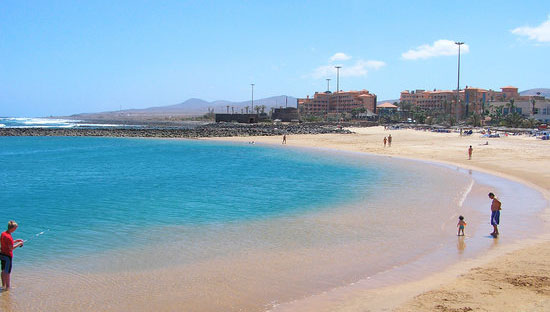 Antigua
Antigua
Antigua is one of the largest towns inside the island, and one of the oldest by the way, but unfortunately, its attractiveness ends there. Apart from the 18th-century church of Nuestra Seńora de Antigua, there is actually nothing worth attention in the town..
Less than a kilometer to the north there is a beautifully restored windmill, Antigua Mill, surrounded by a small cactus garden. A restaurant and a handicraft shop are located in the adjacent buildings (endorsed by the local government, sells only handicrafts made on the island).
The bus line stops in the village #1. You can stay overnight in the stylish Era de la Corte hotel, decorated in a restored traditional building.
Mafasca lights
From November to February, you can see stray blue and red lights around Antigua at night after rain. According to local beliefs, these are the wandering souls of shepherds, who used a wooden cross standing at a crossroads to kindle a fire. Scientists have a slightly different explanation for this phenomenon – The reason for the lights that appear at night is the specific chemical composition of the earth around the town. Strange lights were most often seen along the road, between Antigua and Triquivijate.
Gardening
The sleepy agricultural town has still not been discovered by tourists. Actually, when it comes to architecture, It does not stand out with anything special – the little white streets around Iglesia de San Miguel Arcangel do it all, what can be seen here. Tuineje is famous throughout the archipelago for an event organized in mid-October to commemorate the victory of the islanders over British pirates., who in the 18th century. raided the area, destroying the statue of the archangel Gabriel. It all starts 12 October morning in Gran Tarajal, where the fascinating staging of the arrival of British privateers in Fuerteventura takes place. In the evening the fiesta moves to Tuineje -from 16.00 participants of the pilgrimage to the Archangel Gabriel line up along the main street of the town. The peregrination is rather like a merry parade – pilgrims from Fuerteventura dressed in regional costumes, and sometimes other islands, they play guitars, they dance and shout over each other. A permanent element of this pilgrimage parade are donkeys pulling ladder carts, loaded with gifts for the Archangel (they are then distributed to needy families). In addition to gifts, carts also carry such amounts of food and wine for pilgrims and observers, that virtually no one gets in front of the figure sober. About 22.00 it's time for traditional dances, and after the fireworks show at midnight, the crazy fun begins. The next day, Fr. 11.00 there is a fight between privateers and islanders in Tuineje, who obviously win and lead the bound prisoners to the church of Archangel Gabriel. After the mass, a solemn procession passes through the streets. Accompanying events (competitions, concerts, dances) they last for several consecutive days.
The line bus stops in Tuineje #1. The family-run Pecafra restaurant is located on site.
The most beautiful routes: from Antigua to Betancuria
Hardly anyone knows, that you can walk from Antigua to Betancuria on foot along the old pilgrimage route. Route (ok. 2 at; medium degree of difficulty) begins in front of the parish church in Antigua. With his back to the temple, you must go west, towards the visible mountain range. The trail that goes up the massif can be seen from a distance, therefore it is enough to follow the road to the end of the asphalt. After a while, neatly appears on both sides, a low stone wall, which marks the trail to the top of the hill. There is a beautiful view of Antigua and Betancuria from the top. The descent to the town below takes approx 30 min.